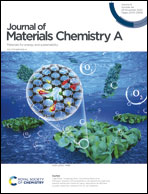A crystalline–amorphous Ni–Ni(OH)2 core–shell catalyst for the alkaline hydrogen evolution reaction†
Abstract
Crystalline–amorphous heterostructures have drawn increasing attention in electrocatalysis by simultaneously taking advantage of the conductive crystalline phase and catalytically active amorphous phase, whereas tuning the composition of the amorphous surface remains a challenge. Herein, we demonstrate a one-step thioacetamide (TAA)-assisted electrodeposition strategy for fabricating crystalline–amorphous Ni–Ni(OH)2 core–shell assembled nanosheets (c-Ni@a-Ni(OH)2) for enhanced alkaline electrocatalytic hydrogen evolution reaction (HER). The TAA induced hydrolysis process is crucial for tuning the composition of the amorphous surface; otherwise, only crystalline–amorphous Ni–NiO (c-Ni@a-NiO) can be obtained. Density functional theory (DFT) calculations reveal that amorphous Ni(OH)2 is more energetically favorable for the HER in comparison to its crystalline counterpart and amorphous NiO. Surface current simulations indicate the important role of the crystalline Ni core in increasing the current density distribution on the amorphous Ni(OH)2 shell. The as-prepared c-Ni@a-Ni(OH)2 catalyst displays highly efficient HER activity and durability in 1.0 M KOH, requiring a low overpotential of 57 mV vs. the reversible hydrogen electrode to deliver a geometric current density of −10 mA cm−2 and a Tafel slope of 44.8 mV dec−1. This work opens up a new avenue for the design and synthesis of unique crystalline–amorphous core–shell materials with controlled surface composition for energy storage and conversion applications.



 Please wait while we load your content...
Please wait while we load your content...